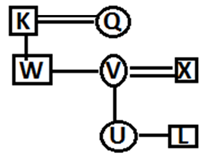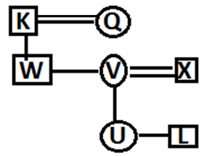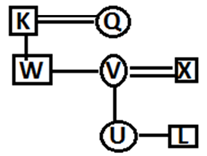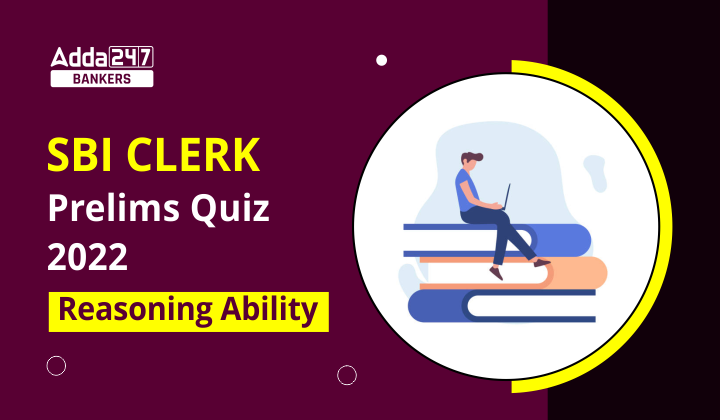Direction (1-5): Study the following alphanumeric series carefully and answer the questions given below:
4 3 2 5 6 5 7 8 9 8 9 1 7 6 4 2 3 1 5 7 1 8 1 8 9 7 5 3 9 8 4 3 5
Q1. How many such even numbers are there which is immediately preceded as well as immediately followed by same odd number?
(a) One
(b) Two
(c) Three
(d) Four
(e) None
Q2. Which of the following number is 15th from right end of the series?
(a) 1
(b) 5
(c) 3
(d) 7
(e) None of these
Q3. How many such odd numbers are there which is immediately preceded by odd numbers and immediately followed by even numbers?
(a) Two
(b) None
(c) One
(d) Four
(e) More than four
Q4. How many numbers are there in between the number which is 10th from left end and the number which is 14th from right end?
(a) Nine
(b) Ten
(c) Eleven
(d) Eight
(e) None of these
Q5. If all odd numbers are eliminated from the series, then, which of the following number is 7th from right end of the series?
(a) 8
(b) 4
(c) 2
(d) 6
(e) None of these
Directions (6-10): Following questions are based on the five three-digit numbers given below.
947 376 694 739 863
Q6. If all the digits in each of the numbers are arranged in increasing order within the number, then, which of the following number will become the lowest in the new arrangement of numbers?
(a) 947
(b) 863
(c) 739
(d) 694
(e) 376
Q7. If all the numbers are arranged in ascending order from left to right then, which of the following will be the sum of all the three digits of the number which is 2nd from the right in the new arrangement?
(a) 18
(b) 19
(c) 15
(d) 16
(e) None of these
Q8. What will be the difference when third digit of the 3rd lowest number is multiplied with the second digit of the highest number and third digit of the 2nd highest number is multiplied with the second digit of the lowest number?
(a) 21
(b) 20
(c) 15
(d)16
(e) None of these
Q9. If the positions of the second and the third digits of each of the numbers are interchanged then, how many even numbers will be formed?
(a) None
(b) One
(c) Two
(d) Three
(e) Four
Q10. If one is added to the second digit of each of the numbers and one is subtracted from the third digit of each number then, how many numbers thus formed will be divisible by three in new arrangement?
(a) None
(b) One
(c) Two
(d) Three
(e) Four
Directions (11-13): Study the following information to answer the given questions.
There are seven members of a family of three generations and two are married couples. K is the father-in-law of X. W is the only son of Q. There are two children of V who is married to brother-in-law of W. U is not the Son of X. L is the grandson of the husband of Q.
Q11. Who is the maternal grandmother of U?
(a) Wife of K
(b) V
(c) W
(d) L
(e) Mother of L
Q12. Who is the daughter of Husband of Q?
(a) W
(b) X
(c) L
(d) V
(e) U
Q13. How is W related to U?
(a) Grand father
(b) Father
(c) Maternal Uncle
(d) Niece
(e) Nephew
Directions (14-15): Study the following information carefully to answer the given questions below.
P is the brother of T. Q is the daughter of T. R is the mother-in-law of Q. R is married to S. U is the only son of S. R has only one child.
Q14. How T is related to U?
(a) Father-in-law
(b) Mother-in-law
(c) Uncle
(d) Can’t be determined
(e) Aunt
Q15. How Q is related to P?
(a) Nephew
(b) Niece
(c) Uncle
(d) Can’t be determined
(e) Aunt
Solutions
S1. Ans. (c)
(989, 565, 181)
S2. Ans. (b)
S3. Ans. (d)
(578, 176, 718, 398)
S4. Ans. (a)
S5. Ans. (d)
S6. Ans. (e)
S7. Ans. (e)
S8. Ans. (c)
S9. Ans. (c)
S10. Ans. (a)
S11. Ans. (a)
Sol.

S12. Ans. (d)
Sol.

S13. Ans. (c)
Sol.

S14. Ans. (d)
Sol.

S15. Ans. (b)
Sol.






 GA Capsule for SBI Clerk Mains 2025, Dow...
GA Capsule for SBI Clerk Mains 2025, Dow...
 The Hindu Review October 2022: Download ...
The Hindu Review October 2022: Download ...
 SBI Clerk Prelims Result 2025 Out, Direc...
SBI Clerk Prelims Result 2025 Out, Direc...







